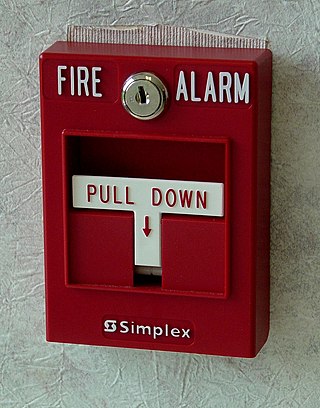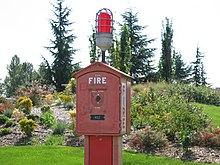
A civil defense siren is a siren used to provide an emergency population warning to the general population of approaching danger. Initially designed to warn city dwellers of air raids during World War II, they were later used to warn of nuclear attack and natural disasters, such as tornadoes. The generalized nature of sirens led to many of them being replaced with more specific warnings, such as the broadcast-based Emergency Alert System and the Cell Broadcast-based Wireless Emergency Alerts and EU-Alert mobile technologies.

Physical security describes security measures that are designed to deny unauthorized access to facilities, equipment, and resources and to protect personnel and property from damage or harm. Physical security involves the use of multiple layers of interdependent systems that can include CCTV surveillance, security guards, protective barriers, locks, access control, perimeter intrusion detection, deterrent systems, fire protection, and other systems designed to protect persons and property.

A smoke detector is a device that senses smoke, typically as an indicator of fire. Smoke detectors/Alarms are usually housed in plastic enclosures, typically shaped like a disk about 150 millimetres (6 in) in diameter and 25 millimetres (1 in) thick, but shape and size vary. Smoke can be detected either optically (photoelectric) or by physical process (ionization). Detectors may use one or both sensing methods. Sensitive alarms can be used to detect and deter smoking in banned areas. Smoke detectors in large commercial and industrial buildings are usually connected to a central fire alarm system.

A fire alarm notification appliance is an active fire protection component of a fire alarm system. A notification appliance may use audible, visible, or other stimuli to alert the occupants of a fire or other emergency condition requiring action. Audible appliances have been in use longer than any other method of notification. Initially, all appliances were either electromechanical horns or electric bells, which would later be replaced by electronic sounders. Most of today's appliances produce sound levels between 70 and 100 decibels at three feet.

A car alarm is an electronic device installed in a vehicle in an attempt to discourage theft of the vehicle itself, its contents, or both. Car alarms work by emitting high-volume sound when the conditions necessary for triggering it are met. Such alarms may also cause the vehicle's headlights to flash, may notify the car's owner of the incident via a paging system, and may interrupt one or more electrical circuits necessary for the car to start. Although inexpensive to acquire and install, the effectiveness of such devices in deterring vehicle burglary or theft when their only effect is to emit sound appears to be negligible.

A security alarm is a system designed to detect intrusions, such as unauthorized entry, into a building or other areas, such as a home or school. Security alarms protect against burglary (theft) or property damage, as well as against intruders. Examples include personal systems, neighborhood security alerts, car alarms, and prison alarms.

A fire alarm control panel (FACP), fire alarm control unit (FACU), fire indicator panel (FIP), or simply fire alarm panel is the controlling component of a fire alarm system. The panel receives information from devices designed to detect and report fires, monitors their operational integrity, and provides for automatic control of equipment, and transmission of information necessary to prepare the facility for fire based on a predetermined sequence. The panel may also supply electrical energy to operate any associated initiating device, notification appliance, control, transmitter, or relay. There are four basic types of panels: coded panels, conventional panels, addressable panels, and multiplex systems.
A false alarm, also called a nuisance alarm, is the deceptive or erroneous report of an emergency, causing unnecessary panic and/or bringing resources to a place where they are not needed. False alarms may occur with residential burglary alarms, smoke detectors, industrial alarms, and in signal detection theory. False alarms have the potential to divert emergency responders away from legitimate emergencies, which could ultimately lead to loss of life. In some cases, repeated false alarms in a certain area may cause occupants to develop alarm fatigue and to start ignoring most alarms, knowing that each time it will probably be false. Intentionally falsely activating alarms in businesses and schools can lead to serious disciplinary actions, and criminal penalties such as fines and jail time.

A passive infrared sensor is an electronic sensor that measures infrared (IR) light radiating from objects in its field of view. They are most often used in PIR-based motion detectors. PIR sensors are commonly used in security alarms and automatic lighting applications.

Manual fire alarm activation is the process of triggering a fire alarm through a call point, pull station, or other device. This usually causes the alarm to sound the evacuation signal for the relevant building or zone. Manual fire alarm activation requires human intervention, as distinct from automatic fire alarm activation such as that provided through the use of heat detectors and smoke detectors. It is, however, possible for call points/pull stations to be used in conjunction with automatic detection as part of the overall fire detection and alarm system. Systems in completed buildings tend to be wired in and include a control panel. Wireless activators are common during construction.

A panic alarm is an electronic device that can easily be activated to request help during an emergency where danger to persons or property exists. It is designed to contact assistance quicker, easier, and simpler than a conventional phone call.

A carbon monoxide detector or CO detector is a device that detects the presence of the carbon monoxide (CO) gas to prevent carbon monoxide poisoning. In the late 1990s Underwriters Laboratories changed the definition of a single station CO detector with a sound device to carbon monoxide (CO) alarm. This applies to all CO safety alarms that meet UL 2034 standard; however for passive indicators and system devices that meet UL 2075, UL refers to these as carbon monoxide detectors. Most CO detectors use a sensor with a defined, limited lifespan, and will not work indefinitely.

A motion detector is an electrical device that utilizes a sensor to detect nearby motion. Such a device is often integrated as a component of a system that automatically performs a task or alerts a user of motion in an area. They form a vital component of security, automated lighting control, home control, energy efficiency, and other useful systems.

An aspirating smoke detector (ASD) is a system used in active fire protection, consisting of a central detection unit which draws air through a network of pipes to detect smoke. The sampling chamber is based on a nephelometer that detects the presence of smoke particles suspended in air by detecting the light scattered by them in the chamber. ASDs can typically detect smoke before it is visible to the naked eye.

A heat detector is a fire alarm device designed to respond when the convected thermal energy of a fire increases the temperature of a heat sensitive element. The thermal mass and conductivity of the element regulate the rate flow of heat into the element. All heat detectors have this thermal lag. Heat detectors have two main classifications of operation, "rate-of-rise" and "fixed temperature". The heat detector is used to help in the reduction of property damage.

A fire alarm system is a building system designed to detect, alert occupants, and alert emergency forces of the presence of fire, smoke, carbon monoxide, or other fire-related emergencies. Fire alarm systems are required in most commercial buildings. They may include smoke detectors, heat detectors, and manual fire alarm activation devices. All components of a fire alarm system are connected to a fire alarm control panel. Fire alarm control panels are usually found in an electrical or panel room. Fire alarm systems generally use visual and audio signalization to warn the occupants of the building. Some fire alarm systems may also disable elevators, which are unsafe to use during a fire under most circumstances.
An annunciator panel, also known in some aircraft as the Centralized Warning Panel (CWP) or Caution Advisory Panel (CAP), is a group of lights used as a central indicator of status of equipment or systems in an aircraft, industrial process, building or other installation. Usually, the annunciator panel includes a main warning lamp or audible signal to draw the attention of operating personnel to the annunciator panel for abnormal events or condition.

A bell box is an audible device, often electric, which when activated, emits a chime, bell, or buzzer sound.

Honeywell Gent, formerly Gents' of Leicester, is a British manufacturer of life safety equipment based in Leicester, England. Established by John Thomas Gent, the company is thought to have started in 1872 however it could have been trading as early as the 1860s. The company had a workforce of several hundred at its height.
An emergency communication system (ECS) is any system that is organized for the primary purpose of supporting one-way and two-way communication of emergency information between both individuals and groups of individuals. These systems are commonly designed to convey information over multiple types of devices, from signal lights to text messaging to live, streaming video, forming a unified communication system intended to optimize communications during emergencies. Contrary to emergency notification systems, which generally deliver emergency information in one direction, emergency communication systems are typically capable of both initiating and receiving information between multiple parties. These systems are often made up of both input devices, sensors, and output/communication devices. Therefore, the origination of information can occur from a variety of sources and locations, from which the system will disseminate that information to one or more target audiences.


















